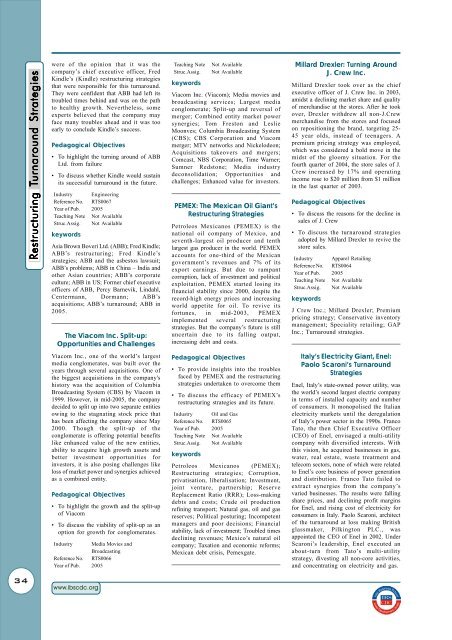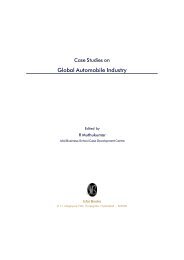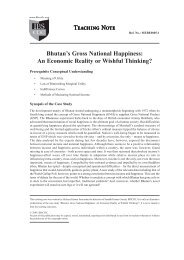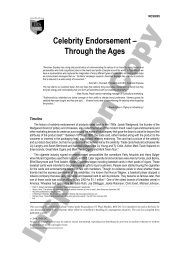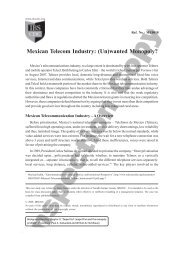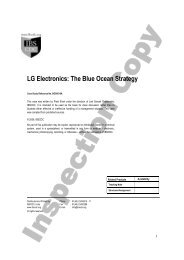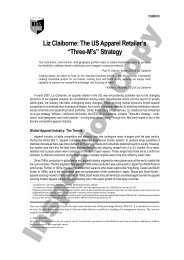List of Case Studies on Strategy - Case Catalogue IV
List of Case Studies on Strategy - Case Catalogue IV
List of Case Studies on Strategy - Case Catalogue IV
You also want an ePaper? Increase the reach of your titles
YUMPU automatically turns print PDFs into web optimized ePapers that Google loves.
34<br />
Restructuring estructuring T TTurnaround<br />
T urnaround Strategies<br />
Strategies<br />
were <str<strong>on</strong>g>of</str<strong>on</strong>g> the opini<strong>on</strong> that it was the<br />
company’s chief executive <str<strong>on</strong>g>of</str<strong>on</strong>g>ficer, Fred<br />
Kindle’s (Kindle) restructuring strategies<br />
that were resp<strong>on</strong>sible for this turnaround.<br />
They were c<strong>on</strong>fident that ABB had left its<br />
troubled times behind and was <strong>on</strong> the path<br />
to healthy growth. Nevertheless, some<br />
experts believed that the company may<br />
face many troubles ahead and it was too<br />
early to c<strong>on</strong>clude Kindle’s success.<br />
Pedagogical Objectives<br />
• To highlight the turning around <str<strong>on</strong>g>of</str<strong>on</strong>g> ABB<br />
Ltd. from failure<br />
• To discuss whether Kindle would sustain<br />
its successful turnaround in the future.<br />
Industry Engineering<br />
Reference No. RTS0067<br />
Year <str<strong>on</strong>g>of</str<strong>on</strong>g> Pub. 2005<br />
Teaching Note Not Available<br />
Struc.Assig. Not Available<br />
keywords<br />
Asia Brown Boveri Ltd. (ABB); Fred Kindle;<br />
ABB’s restructuring; Fred Kindle’s<br />
strategies; ABB and the asbestos lawsuit;<br />
ABB’s problems; ABB in China – India and<br />
other Asian countries; ABB’s corporate<br />
culture; ABB in US; Former chief executive<br />
<str<strong>on</strong>g>of</str<strong>on</strong>g>ficers <str<strong>on</strong>g>of</str<strong>on</strong>g> ABB, Percy Barnevik, Lindahl,<br />
Centermann, Dormann; ABB’s<br />
acquisiti<strong>on</strong>s; ABB’s turnaround; ABB in<br />
2005.<br />
The Viacom Inc. Split-up:<br />
Opportunities and Challenges<br />
Viacom Inc., <strong>on</strong>e <str<strong>on</strong>g>of</str<strong>on</strong>g> the world’s largest<br />
media c<strong>on</strong>glomerates, was built over the<br />
years through several acquisiti<strong>on</strong>s. One <str<strong>on</strong>g>of</str<strong>on</strong>g><br />
the biggest acquisiti<strong>on</strong>s in the company's<br />
history was the acquisiti<strong>on</strong> <str<strong>on</strong>g>of</str<strong>on</strong>g> Columbia<br />
Broadcasting System (CBS) by Viacom in<br />
1999. However, in mid-2005, the company<br />
decided to split up into two separate entities<br />
owing to the stagnating stock price that<br />
has been affecting the company since May<br />
2000. Though the split-up <str<strong>on</strong>g>of</str<strong>on</strong>g> the<br />
c<strong>on</strong>glomerate is <str<strong>on</strong>g>of</str<strong>on</strong>g>fering potential benefits<br />
like enhanced value <str<strong>on</strong>g>of</str<strong>on</strong>g> the new entities,<br />
ability to acquire high growth assets and<br />
better investment opportunities for<br />
investors, it is also posing challenges like<br />
loss <str<strong>on</strong>g>of</str<strong>on</strong>g> market power and synergies achieved<br />
as a combined entity.<br />
Pedagogical Objectives<br />
• To highlight the growth and the split-up<br />
<str<strong>on</strong>g>of</str<strong>on</strong>g> Viacom<br />
• To discuss the viability <str<strong>on</strong>g>of</str<strong>on</strong>g> split-up as an<br />
opti<strong>on</strong> for growth for c<strong>on</strong>glomerates.<br />
Industry Media Movies and<br />
Broadcasting<br />
Reference No. RTS0066<br />
Year <str<strong>on</strong>g>of</str<strong>on</strong>g> Pub. 2005<br />
www.ibscdc.org<br />
Teaching Note Not Available<br />
Struc.Assig. Not Available<br />
keywords<br />
Viacom Inc. (Viacom); Media movies and<br />
broadcasting services; Largest media<br />
c<strong>on</strong>glomerate; Split-up and reversal <str<strong>on</strong>g>of</str<strong>on</strong>g><br />
merger; Combined entity market power<br />
synergies; Tom Frest<strong>on</strong> and Leslie<br />
Mo<strong>on</strong>ves; Columbia Broadcasting System<br />
(CBS); CBS Corporati<strong>on</strong> and Viacom<br />
merger; MTV networks and Nickelode<strong>on</strong>;<br />
Acquisiti<strong>on</strong>s takeovers and mergers;<br />
Comcast, NBS Corporati<strong>on</strong>, Time Warner;<br />
Sumner Redst<strong>on</strong>e; Media industry<br />
dec<strong>on</strong>solidati<strong>on</strong>; Opportunities and<br />
challenges; Enhanced value for investors.<br />
PEMEX: The Mexican Oil Giant’s<br />
Restructuring Strategies<br />
Petroleos Mexicanos (PEMEX) is the<br />
nati<strong>on</strong>al oil company <str<strong>on</strong>g>of</str<strong>on</strong>g> Mexico, and<br />
seventh-largest oil producer and tenth<br />
largest gas producer in the world. PEMEX<br />
accounts for <strong>on</strong>e-third <str<strong>on</strong>g>of</str<strong>on</strong>g> the Mexican<br />
government’s revenues and 7% <str<strong>on</strong>g>of</str<strong>on</strong>g> its<br />
export earnings. But due to rampant<br />
corrupti<strong>on</strong>, lack <str<strong>on</strong>g>of</str<strong>on</strong>g> investment and political<br />
exploitati<strong>on</strong>, PEMEX started losing its<br />
financial stability since 2000, despite the<br />
record-high energy prices and increasing<br />
world appetite for oil. To revive its<br />
fortunes, in mid-2003, PEMEX<br />
implemented several restructuring<br />
strategies. But the company’s future is still<br />
uncertain due to its falling output,<br />
increasing debt and costs.<br />
Pedagogical Objectives<br />
• To provide insights into the troubles<br />
faced by PEMEX and the restructuring<br />
strategies undertaken to overcome them<br />
• To discuss the efficacy <str<strong>on</strong>g>of</str<strong>on</strong>g> PEMEX’s<br />
restructuring strategies and its future.<br />
Industry Oil and Gas<br />
Reference No. RTS0065<br />
Year <str<strong>on</strong>g>of</str<strong>on</strong>g> Pub. 2005<br />
Teaching Note Not Available<br />
Struc.Assig. Not Available<br />
keywords<br />
Petroleos Mexicanos (PEMEX);<br />
Restructuring strategies; Corrupti<strong>on</strong>,<br />
privatisati<strong>on</strong>, liberalisati<strong>on</strong>; Investment,<br />
joint venture, partnership; Reserve<br />
Replacement Ratio (RRR); Loss-making<br />
debts and costs; Crude oil producti<strong>on</strong><br />
refining transport; Natural gas, oil and gas<br />
reserves; Political posturing; Incompetent<br />
managers and poor decisi<strong>on</strong>s; Financial<br />
stability, lack <str<strong>on</strong>g>of</str<strong>on</strong>g> investment; Troubled times<br />
declining revenues; Mexico’s natural oil<br />
company; Taxati<strong>on</strong> and ec<strong>on</strong>omic reforms;<br />
Mexican debt crisis, Pemexgate.<br />
Millard Drexler: Turning Around<br />
J. Crew Inc.<br />
Millard Drexler took over as the chief<br />
executive <str<strong>on</strong>g>of</str<strong>on</strong>g>ficer <str<strong>on</strong>g>of</str<strong>on</strong>g> J. Crew Inc. in 2003,<br />
amidst a declining market share and quality<br />
<str<strong>on</strong>g>of</str<strong>on</strong>g> merchandise at the stores. After he took<br />
over, Drexler withdrew all n<strong>on</strong>-J.Crew<br />
merchandise from the stores and focused<br />
<strong>on</strong> repositi<strong>on</strong>ing the brand, targeting 25-<br />
45 year olds, instead <str<strong>on</strong>g>of</str<strong>on</strong>g> teenagers. A<br />
premium pricing strategy was employed,<br />
which was c<strong>on</strong>sidered a bold move in the<br />
midst <str<strong>on</strong>g>of</str<strong>on</strong>g> the gloomy situati<strong>on</strong>. For the<br />
fourth quarter <str<strong>on</strong>g>of</str<strong>on</strong>g> 2004, the store sales <str<strong>on</strong>g>of</str<strong>on</strong>g> J.<br />
Crew increased by 17% and operating<br />
income rose to $20 milli<strong>on</strong> from $1 milli<strong>on</strong><br />
in the last quarter <str<strong>on</strong>g>of</str<strong>on</strong>g> 2003.<br />
Pedagogical Objectives<br />
• To discuss the reas<strong>on</strong>s for the decline in<br />
sales <str<strong>on</strong>g>of</str<strong>on</strong>g> J. Crew<br />
• To discuss the turnaround strategies<br />
adopted by Millard Drexler to revive the<br />
store sales.<br />
Industry Apparel Retailing<br />
Reference No. RTS0064<br />
Year <str<strong>on</strong>g>of</str<strong>on</strong>g> Pub. 2005<br />
Teaching Note Not Available<br />
Struc.Assig. Not Available<br />
keywords<br />
J Crew Inc.; Millard Drexler; Premium<br />
pricing strategy; C<strong>on</strong>servative inventory<br />
management; Speciality retailing; GAP<br />
Inc.; Turnaround strategies.<br />
Italy’s Electricity Giant, Enel:<br />
Paolo Scar<strong>on</strong>i’s Turnaround<br />
Strategies<br />
Enel, Italy’s state-owned power utility, was<br />
the world’s sec<strong>on</strong>d largest electric company<br />
in terms <str<strong>on</strong>g>of</str<strong>on</strong>g> installed capacity and number<br />
<str<strong>on</strong>g>of</str<strong>on</strong>g> c<strong>on</strong>sumers. It m<strong>on</strong>opolised the Italian<br />
electricity markets until the deregulati<strong>on</strong><br />
<str<strong>on</strong>g>of</str<strong>on</strong>g> Italy’s power sector in the 1990s. Franco<br />
Tato, the then Chief Executive Officer<br />
(CEO) <str<strong>on</strong>g>of</str<strong>on</strong>g> Enel, envisaged a multi-utility<br />
company with diversified interests. With<br />
this visi<strong>on</strong>, he acquired businesses in gas,<br />
water, real estate, waste treatment and<br />
telecom sectors, n<strong>on</strong>e <str<strong>on</strong>g>of</str<strong>on</strong>g> which were related<br />
to Enel’s core business <str<strong>on</strong>g>of</str<strong>on</strong>g> power generati<strong>on</strong><br />
and distributi<strong>on</strong>. Franco Tato failed to<br />
extract synergies from the company’s<br />
varied businesses. The results were falling<br />
share prices, and declining pr<str<strong>on</strong>g>of</str<strong>on</strong>g>it margins<br />
for Enel, and rising cost <str<strong>on</strong>g>of</str<strong>on</strong>g> electricity for<br />
c<strong>on</strong>sumers in Italy. Paolo Scar<strong>on</strong>i, architect<br />
<str<strong>on</strong>g>of</str<strong>on</strong>g> the turnaround at loss making British<br />
glassmaker, Pilkingt<strong>on</strong> PLC., was<br />
appointed the CEO <str<strong>on</strong>g>of</str<strong>on</strong>g> Enel in 2002. Under<br />
Scar<strong>on</strong>i’s leadership, Enel executed an<br />
about-turn from Tato’s multi-utility<br />
strategy, divesting all n<strong>on</strong>-core activities,<br />
and c<strong>on</strong>centrating <strong>on</strong> electricity and gas.


